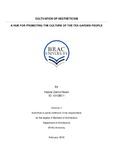| dc.contributor.advisor | Mahmudun Nobi, Abul Fazal | |
| dc.contributor.advisor | Sajid-Bin-Doza | |
| dc.contributor.advisor | Khan, Tanzina | |
| dc.contributor.advisor | Kaikobad, S.M | |
| dc.contributor.author | Azam, Hasnat Zamiul | |
| dc.date.accessioned | 2018-06-05T04:49:33Z | |
| dc.date.available | 2018-06-05T04:49:33Z | |
| dc.date.copyright | 2018 | |
| dc.date.issued | 2018-02 | |
| dc.identifier.other | ID 13108011 | |
| dc.identifier.uri | http://hdl.handle.net/10361/10258 | |
| dc.description | This thesis is submitted in partial fulfillment of the requirements for the degree of Bachelor of Architecture, 2018. | en_US |
| dc.description | Cataloged from PDF version of thesis. | |
| dc.description | Includes bibliographical references (page 58). | |
| dc.description.abstract | The history of tea workers in Bangladesh goes way back 150 years into the British period and these indigenous people have a history of rich culture and rituals. But these workers, due to the flow of time and exploitation are losing their rich culture and norms. Tea workers are obviously socially excluded people who are ignored and socially treated as untouchables. As citizens of Bangladesh, they have the right to live anywhere in the country, but the reality is, most of the community have never stepped out of the garden. This type of isolation and social barricade has put a tremendous effect on their life and culture. As a result, they are being deprived and losing their rich cultures and norms. In order to protect their remaining cultures and preserve them, a culture exposure is a must. The project is to design a cultural hub, which will be a bridge to preserve and bring these dying cultures into light. A cultural complex is proposed to attract tourists from around the country and world, where the cultures and rituals and handicrafts will be exhibited. A vocational training center is proposed where the diminishing cultures will be practiced so that they are preserved and practiced. Accommodation for tourists and guests are also provided. This project will be a bridge between the Outer world and the ethnic group of tea workers who have been living in isolation for generations. | en_US |
| dc.description.statementofresponsibility | Hasnat Zamiul Azam | |
| dc.format.extent | 58 pages | |
| dc.language.iso | en | en_US |
| dc.publisher | BRAC University | en_US |
| dc.rights | BRAC University theses reports are protected by copyright. They may be viewed from this source for any purpose, but reproduction or distribution in any format is prohibited without written permission. | |
| dc.subject | Tea garden | en_US |
| dc.subject | Cultural hub | en_US |
| dc.subject | Aestheticism | en_US |
| dc.title | Cultivation of aestheticism : a hub for promoting the culture of the tea garden people | en_US |
| dc.type | Thesis | en_US |
| dc.contributor.department | Department of Architecture, BRAC University | |
| dc.description.degree | B. Architecture | |

